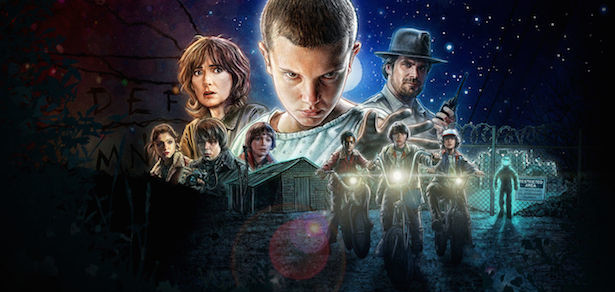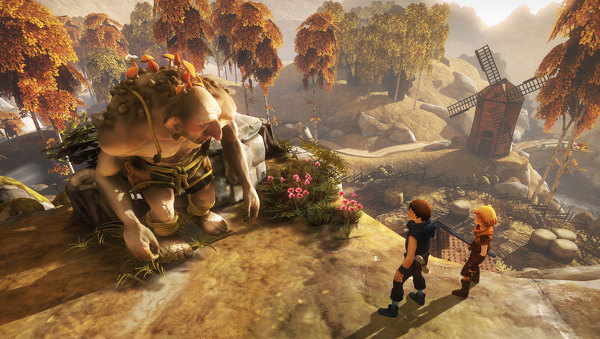In the opening cinematic of Lightning Returns: Final Fantasy XIII, the titular character Claire “Lightning” Farron stands atop a clock tower, the glow of a fantastical city below her. She dramatically removes the sunglasses off her face, announcing her return not only to the fictional world that has progressed 500 years since her last appearance but to Square Enix’s Final Fantasy lineup as well. Although some question the necessity of turning their thirteenth major installment into a trilogy, I have a fondness for the Final Fantasy XIII world. With each additional installation, Square Enix has at least tried to incorporate player feedback, experimenting with different or modified elements from that of the previous edition. However while Final Fantasy XIII-2‘s changes were relatively tame, Lightning Returns‘ are large and drastic: an overhauled combat system, new open world settings, and the introduction of a time restriction element has resulted in a game that hardly resembles its predecessors.
Rather than splitting focus between multiple team members as was the case in XIII and, less prominently, in XIII-2, in Lightning Returns you exclusively control Lightning. The story continues 500 years where the previous left off. Lightning, having spent these years in a crystal slumber, is awoken by Bhunivelze, the central deity of the world. Chaos has grown uncontrollable even for the gods and Bhunivelze, using Lightning’s previous comrade Hope Estheim as an intermediary between the two, plans to create a new world altogether in just thirteen days. Thus Lightning is tasked with saving the souls of as many people as possible in the time she is given.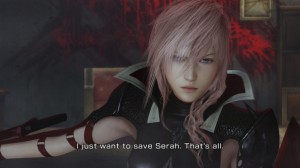
The story is admittedly… simplistic in certain aspects yet perplexing in others, at least given what I’ve encountered so far. Much of the motivation for Lightning’s actions comes with the reasoning of “because god says so,” and for the most part Lightning goes along with it out of a desire to save her sister, a reward promised to her by Bhunivelze upon completion of his task. Lightning’s character motivation has largely been reduced to a desire to achieve this rather linear focus. At times it seems as is if this “god’s will” is used as a means to an end in the story, as a way of excusing or giving reason to certain actions. Although it is the third in the series, reflections or flashbacks on previous events and a slight disconnect from the context of the previous games allows this edition to stand alone fairly well. Ultimately an interest in exploring this new world and the promise of achieving for Lightning, and the other characters for that matter, a decisive ending helps to mitigate the issues I have with the plot, but this might not be enough for everyone to get invested or interested.
However what Lightning Returns is lacking in its fairly average story it makes up in gameplay. The game is decisively non-linear, a point that characterized much of the criticism of the original. Although you have the opportunity to have thirteen days until the end of the world, you must earn that number by performing quests. Partially because the game is so extensively open world, the game offers a numerous amount of main and side quests – too numerous, even, as the countdown of the clock requires that, as Lightning herself put it, you pick and choose what to do and who to save – that the player can decide what to do each day. With each in-game hour being worth approximately a minute in real time and certain objects, quests, or goals only available at certain times of the day, the clock can easily become your enemy. The tendency to wander around and thoroughly search each location 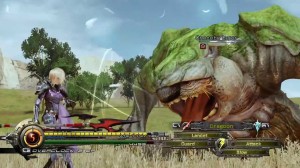 (which I am generally a fan of) doesn’t work well here. Travel takes time, as does staying at an inn to rejuvenate health, and a variety of other activities so a well thought out time management strategy is beneficial. However the game allows you to progress as you see fit with almost no restrictions and the more quests you accomplish, the more additional time gets added to the clock.
(which I am generally a fan of) doesn’t work well here. Travel takes time, as does staying at an inn to rejuvenate health, and a variety of other activities so a well thought out time management strategy is beneficial. However the game allows you to progress as you see fit with almost no restrictions and the more quests you accomplish, the more additional time gets added to the clock.
One of the most enriching additions to Lightning Returns is the revamped combat system. As it borrows both the real time battle and dress sphere systems from Final Fantasy X-2, merely setting up a formation and pressing a button to attack wont cut it anymore. In fact, mastering combat can be downright challenging, but that’s what makes it feel rewarding. Lightning can employ three “schemata” for use in battle that function like character classes; some are designed for magic use, others for sabotaging the enemy, and some for physical power, among others. Each schemata is composed of an outfit, weapon, and shield. Each individual item adds a variety of benefits. Refreshingly, changing between each schemata is instantaneous and is almost a necessity as enemies attack fast and hard. The player is required to devise the best strategy and schematas for each opponent while balancing being on the offensive and defensive as you actively attack and guard. Rather than gaining experience points from defeating opponents, completing quests strengthens Lightning, with enemies providing items, Gil, and the credits needed to 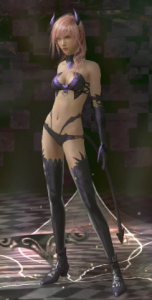 activate Lightning’s “special” powers that allow her, among other things, to temporarily stop the progression of time.
activate Lightning’s “special” powers that allow her, among other things, to temporarily stop the progression of time.
However, like FFX-2, these schematas revolve around costume changes, some of which are impractical to say the least. These range from complete sets of knight or samurai armor to little more than lingerie (pictured is one of the worst offenders). This comprises one of the only real problematic complaints I have towards the game: a perpetuation of over-sexualized and just plain unrealistic costuming choices for female characters. While you can theoretically avoid the questionable outfits, the presence of the problem still persists. Plus there’s just something ridiculous about a world savior running around defeating monsters in bikinis. The Square Enix certainly does know, however, how to market off nostalgia as well, as Cloud’s (FFVII) and Yuna’s (FFX) outfits are available as pre-order content and DLC. As trivial as these are, it’s an enticing addition to the “dress up” aspect of the game.
Costuming problems aside, Lightning Returns: Final Fantasy XIII reveals its strength in its mechanics and gameplay, although the story leaves something to be desired.

